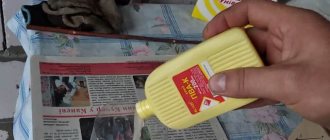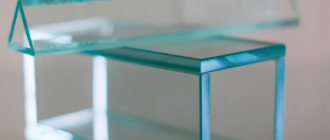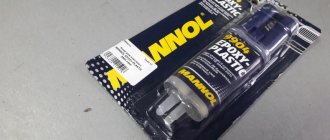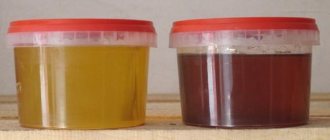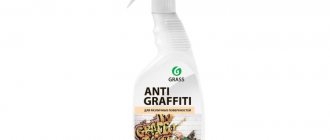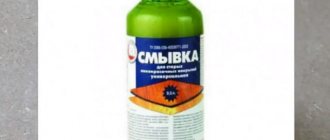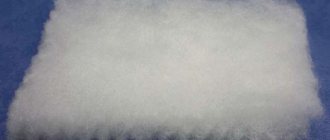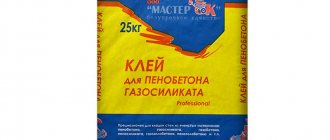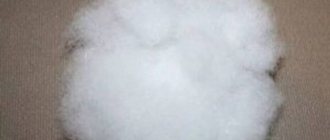Titanium glue is a universal glue, which is explained by its high technological properties. Titanium can be used for gluing products made of foam plastic, wood, PVC, leatherette and others. It has proven itself well for installing finishing elements on surfaces made of concrete, wood, plaster, including ceiling tiles. The adhesive can be used for external and internal work; the connection is characterized by elasticity, moisture resistance and frost resistance. Eco-friendly because does not contain solvents hazardous to health. If Titanium has thickened, you can use alcohol, including salicylic acid or denatured alcohol, to dilute it. In its liquid state, Titanium does not bond well, but can be used as a primer. Craftsmen, when advising how to dilute Titan glue, can point to nail remover. It should be borne in mind that the use of isopropanol-based nail remover may cause the glue to curdle (photo).
Properties and characteristics of Titan glue
When performing repair and finishing work in an apartment, the adhesive composition is an indispensable attribute that allows you to quickly and reliably fasten facing materials and various parts to the walls and ceiling. Therefore, one of the main criteria when choosing an adhesive is its versatility. In this regard, among many manufacturers, the leader is Titan adhesive, which provides reliable connection of various finishing materials, including ceiling tiles, with concrete, wood and plaster surfaces.
The main advantages of the Titan adhesive composition are:
- Economical consumption;
- Possibility of application for internal and external work;
- Interaction with a wide range of materials;
- No need to prepare a solution;
- Elasticity and moisture resistance in any climatic conditions;
- Lack of color;
- No components harmful to health.
Peculiarities
Tytan glue is a universal composition that can be used to work with various surfaces. In the product catalog you will find compositions for tiles, plastic, polystyrene foam and other materials.
The product contains many components. Each option, regardless of its purpose, has excellent technical characteristics that meet high quality standards.
The glue is characterized by increased resistance to external irritants.
Experts highlight the following main characteristics of products from the Tytan brand:
- complete absence of load on the surface of the base;
- safe use for health due to the environmental friendliness of the composition;
- increased resistance to high temperatures (up to 100°C);
- the seam holds water on the surface, preventing it from penetrating under the finish;
- excellent viscosity and elasticity;
- high adhesion;
- wide range of uses with natural and artificial materials;
- resistance to frost.
Method of using Titanium adhesive for ceiling tiles
Regardless of the choice of adhesive composition and method of application, before applying adhesive for foam ceiling tiles, it is necessary to carefully prepare the ceiling surface. All existing cracks and crevices must be repaired and completely sealed.
Tiles can only mask minor irregularities, so if there are significant differences in the ceiling, then its surface must be leveled, then a layer of finishing putty must be applied, and then primed. In addition, it is not recommended to glue ceiling tiles to whitewash.
The method of using Titan glue depends on the form of release and is indicated by the manufacturer on the packaging. There are three main types of adhesive:
Used for gluing ceiling tiles, parquet, linoleum and wood. It is a colorless composition that is squeezed out in a thin strip from a sealed package. To glue ceiling tiles, glue is applied to its inner surface in a broken line, after which it needs to dry for 2-3 minutes. Next, the tiles are pressed tightly against the ceiling, the glue instantly sets and hardens within an hour.
Complete drying occurs within a day after application.
- Glue mastic.
Suitable for gluing any materials, including concrete, cement and plasterboard, as well as for leveling the surface when installing ceiling tiles. Before use, mix thoroughly, then apply with a spatula in the center of the tile and at 3 points along its perimeter. Next, the tile is pressed against the ceiling, after which its position can be adjusted within a few seconds. The mastic hardens 12 hours after application.
Interacts with all types of surfaces and is suitable for outdoor use. The adhesive composition is applied using a special gun in a thick layer, therefore it is used for cladding ceilings with severe surface irregularities.
Instructions for use
The options for using Titan Wild glue are varied, and therefore can significantly save money. One package of such material can replace many other means required for repair and construction.
Recommendations for use:
- apply Titan glue only to a previously degreased, flat surface, and the layer should not be too thick, otherwise the gluing will be of poor quality;
- allow the composition to dry after application for two to five minutes, then connect the surfaces to be fastened;
- the glue will dry completely in 60 minutes, the maximum strength of the seam is achieved after 24 hours;
- Apply the composition in two layers to the porous surface;
- installation of ceiling tiles involves applying glue in small intervals;
- It is strictly forbidden to apply glue to whitewash; it must first be removed and the surface thoroughly treated with a primer - a mixture of glue and denatured alcohol.
In some cases, when the repair is already completed, you can see minor defects in the form of a loose corner of a tile, linoleum or wallpaper. All these shortcomings will be eliminated by Tytan glue, as it is highly effective.
What to do if the glue has thickened
During application, the universal adhesive composition Titan may thicken, which negatively affects its characteristics. In order to return it to its original properties, you can dilute the glue. For these purposes, use one of the types of alcohol:
- Ethyl (medical);
- Salicylic (alcohol solution of salicylic acid);
- Technical (denatured alcohol).
The use of nail polish remover containing acetone and isopropyl alcohol as a solvent is not recommended, since this composition may cause the adhesive to curdle.
Removing dried adhesive from surfaces is a painstaking undertaking, which is complicated by the presence of high-quality components in its composition. Anyone who knows how to dissolve glue can get rid of the problem. Chemically active solvent materials of natural or synthetic origin can help in solving this problem.
Varieties
The universal model is indispensable in any situation if it is used by an unpretentious consumer with a desire to save money in his wallet and space on the shelf. However, in addition to it, there are more than a dozen versions that differ from the basic one either slightly or radically.
Some transform so much that they actually take on a different form. Analyzing all possible variations is a tedious task, so it is enough to turn to the popular and in demand ones.
The most accessible solvents
The most universal natural remedy, which can be used to remove dried traces of carpentry, plant, stationery and polyvinyl acetate compounds, is water. To clean the surface, simply blot the fresh residue quickly and rinse with water until the sticky residue disappears. Unfortunately, if the stain is old and firmly ingrained, then it is not possible to remove it using such a solvent.
Another popular product that can be used to dissolve glue has proven itself to be sunflower and baby oils. Each of them needs to grease the dried residue several times and wait a while. It will gradually lose its adhesive properties, and the solvent will mix with it, since many types of adhesive mixtures are oil-based. Upon completion of the procedure, the remaining marks are easily erased, and the surface is rinsed with water. Vaseline has a similar property; its high fat content promotes the rapid breakdown of molecules.
Among natural solvents, ordinary vinegar can be distinguished. You should wipe the stained area with it and wait half an hour. During this time, the stain will begin to lose strength, dissolve in acid, and the residue will need to be wiped off.
A mixture of baking soda and water in a 2:1 ratio is very effective in this matter. This paste-like substance is applied to the contaminated area, wait until the clot is completely dissolved and rinse with water.
Alcohol is considered an effective solvent, capable of decomposing many adhesive compositions. When applying this drug to the stained area after 5-10 minutes. the strong clot will soften. Next, the residues are freely removed during the process of wet wiping. Acetone has a similar effect, but should be used carefully when cleaning synthetic surfaces. Other known solvents are: gasoline, turpentine, white spirit, ammonia. When using them, for greater efficiency, the adhesive clot is preheated with a hairdryer. Thus, the process of its removal is accelerated.
Tytan Professional sealants
Titan Professional offers high-quality sealants for any task: silicone and silicate sealants, acrylic, polymer, polyurethane (PU), bitumen and rubber sealants. In addition to universal and multi-purpose compounds, the brand offers specialized sealants (roofing, for example).
Silicone sealant
Titanium silicone sealants have proven themselves well in professional circles. They have a high level of adhesion to most materials and are resistant to various weather conditions. The universal sealant is used not only to seal seams and seal joints, but also to seal wires and protect polyurethane foam from ultraviolet radiation. Withstands 1 freezing cycle.
In addition to the universal range of Tytan silicone sealants, it includes sanitary sealant, glass sealant, kitchen and bathroom sealant, marble sealant, window, door and siding sealant, acrylic bathtub sealant, high temperature sealant, etc.
Multi-purpose sealant
Tytan Multi-Purpose Sealant (Hybrid) can be used to bond and seal even on wet surfaces. The composition is odorless and does not contain solvents, so after drying it can be painted.
This sealant practically does not age and retains its elasticity.
Like the entire Titan line, the multi-purpose sealant is suitable for most building materials: ceramics, glass, concrete, cement, stone, metal, wood, polycarbonate, PVC, etc. The sealant is excellent for roofing work.
Acrylic sealant
The brand’s acrylic sealant has a high level of adhesion to porous materials; it can be applied to wet surfaces and can also be painted after drying. The sealant quickly forms a film that can be removed before complete hardening; then only a mechanical method will help.
How to remove PVA?
Of all existing adhesives, PVA is the most susceptible to dissolution. The arsenal of tools that can be used to dissolve PVA glue includes the following materials:
- 1. hot soapy solution – when treating with this material, the surface should be washed with 9% acetic acid or 96% alcohol;
- 2. baking soda perfectly softens hardened residues; to get the result, you need to walk a hard sponge with soda over the PVA layer - it will be wiped off in a minute;
- 3. water softens the dried PVA clot, its soluble elements are separated from the emulsified suspension, the remains can be wiped off with a rag moistened with acetone, methanol, isobenzene or ethyl acetate.
Features of removing different types of adhesive composition
Depending on the type of glue, different means are used to remove it:
PVA - water, boiling water, soap solution, soda.- Superglue, Moment - acetone, Anti-glue.
- Titanium – solvents, acetone.
- Cosmofen - solvents, Dimexide.
- Hot melt adhesive - hair dryer.
- Silicate glue – Dimexide, solvent, gasoline.
- Liquid nails - acetone.
- Silicone - alcohol, glass cleaner, hot water.
Read about how to remove sticker adhesive from plastic here.
How to get rid of traces of Super Glue and Moment glue?
A product such as Super Glue glues any materials together in a matter of seconds. Before you start working with it, you need to familiarize yourself with how to dissolve Super Glue if you need to correct mistakes. Several factors influence the choice of solvent:
- • how long ago the adhesive was used,
- • the type of surface on which it is located,
- • purity of the expected result.
The main thing is not to miss the time of its hardening. Otherwise, the work will become significantly more complicated; most often, the stained surface will lose its attractiveness irrevocably.
Among the effective methods for dissolving Super Glue, as well as its analogue Moment, acetone should be highlighted. However, it has a negative effect on varnished materials and may cause more harm than good. This should be taken into account before starting cleaning work. It is possible to remove a fresh stain in a couple of hours using dimethyl sulfoxide, which is freely available in any pharmacy.
Specifications
"Titan" glue does not lose its quality characteristics, even if it is used at different ambient temperatures. The composition is characterized by resistance to direct sunlight and excellent elasticity. After gaining strength, it does not become brittle and is not prone to delamination. Environmentally friendly, does not contain substances harmful to the human body.
Glue properties:
- used for indoor and outdoor work;
- suitable for gluing almost any materials;
- economically used;
- ideally glues polystyrene foam;
- the seam is waterproof and elastic;
- colorless, transparent;
- sold completely ready for use;
- does not contain substances harmful to the human body;
- the elasticity of the composition does not change under the influence of different climatic conditions.
How to dissolve stubborn adhesives?
Many people do not know how to dissolve Titan glue, which belongs to the class of very resistant and difficult to remove compounds based on acrylic copolymers. Effective means that help dissolve it are concentrated plumbing acid, gasoline, dimethyl ketone, turpentine, methylbenzene, ethyl acetate. After soaking in these products, it is necessary to remove the residues mechanically.
When choosing a method for dissolving epoxy glue, you should remember that this will have a significant impact on the performance properties of the final polymer. The addition of solvents helps reduce viscosity, and the strength and water resistance characteristics of the product deteriorate. Suitable for dilution are acetone and denatured alcohol, which can evaporate quickly without remaining in the resin.
When choosing a product to dissolve rubber or 88 glue in case of drying, you can choose gasoline, since it is included in their composition. Dilute the adhesive composition to the consistency of liquid sour cream so that it does not drain from the roller.
Key factors to consider when breeding:
- 1. Adding a solvent significantly reduces the viscosity and strength of the polymer.
- 2. The service life of the adhesive and its curing period are increased.
- 3. Dilution causes the resin to shrink, which increases microcracks.
- 4. The color of the polymer changes.
- 5. Increases fluidity on verticals.
Each of us has had to deal with the problem of removing glue from surfaces such as plastic, wood, laminate, linoleum, clothing, etc. But the question always arises: how can you dissolve Superglue, Moment, PVA, PVC, Titanium and other most popular adhesive bases? There are many ways you can dissolve glue. In our article we will look at the most useful and practical tips on how to quickly remove glue using modern means.
Advantages and disadvantages
Let's start with the pleasant moments.
Titan adhesive used for wallpapering is equipped with a special indicator that will allow you to control its application and you will not leave dry spots on the canvas.
Previous glue package
In accordance with modern standards for the production of wallpaper adhesives, Titan is equipped with all types of additives against mold, mildew, and microbes, while it is absolutely non-toxic and safe for human and animal health.
It is diluted in the standard way: poured into water, mixed, without forming lumps or clots.
The kneading time until ready is 5 minutes.
The finished glue is able to maintain its properties for a whole month, which is an unprecedented property.
When glue gets on the decorative side of the wallpaper, it does not leave any traces, even after drying.
A pumped-up man symbolizes the power of glue
The special composition of the glue allows you to hold the wallpaper on the wall and gives time to adjust its position. Therefore, you will have enough time to clearly join the drawing.
The cost of Titan glue is in the middle price segment, it is available to anyone.
However, there are also unpleasant moments, which we will also talk about.
When mixing the glue, if you do not want lumps, you should mix the composition very carefully, while pouring out the powder in a thin stream. You shouldn’t pour it all at once, it will be very difficult to mix.
If you don’t want to do this with your hands, take a mixer and a drill, the task will be simplified several times.
The indicator quickly loses color. Initially the glue is pink, but when applied to the canvas, it quickly discolors and becomes transparent. At the same time, it is clearly visible that the smeared canvas shines slightly, but this property is present when applying any glue.
It is advisable to dilute the glue in less water than indicated on the package. However, technological application under ideal conditions does not reflect the real picture.
Modern products and concentrates
To clean unnecessary glue stains from various surfaces, we will need assistants, which are modern chemicals. As a rule, such products can deal with adhesive stains in a few minutes.
So how to dissolve Superglue? Some housewives use products such as alcohol, acetone, soap, vinegar, and water to combat the adhesive base. All of these remedies are effective, especially if they are combined with each other. But this depends on the nature of the pollution.
Let's take a closer look at each method for removing adhesive stains.
Polyurethane foam STD
Tytan STD one-component polyurethane foam is used to fill and seal joints, cracks and other gaps. Most often used when installing windows and doors. Ideal for wood, stone, concrete and metal.
Advantages of STD foam:
- does not require additional equipment (the bottle is equipped with a special applicator);
- noise insulation up to 62 dB;
- thermal insulation;
- ergonomic packaging;
- can be used for 2 months;
- rapid hardening;
- prevents the appearance of fungus and mold.
Mode of application:
Before use, shake the container thoroughly and then keep it upside down. Apply foam to a clean, degreased and damp surface using an applicator. When hardened, the composition doubles in size.
PVA glue
How can you dissolve PVA glue so as not to spoil the surface? This type of adhesive is the most amenable to cleaning, and there are no particular difficulties with it. It can be removed from surfaces such as wood, metal, plastic, using a wooden spatula or a construction spatula; it can also be cleaned using a knife. In order not to damage the surface from which PVA should be removed, the adhesive area must be moistened with warm water. Next, the surface needs to be treated with a solution. This can be acetone, benzene, methanol, ethyl acetate and other analogues.
If you need to remove PVA glue from clothing or other fabric products, you need to soak the adhesive stain in a soapy solution for several minutes. Afterwards rinse in clean water. Then you need to apply medical alcohol or vinegar to a dry cloth or napkin and wipe the area where the glue was previously.
What glues and what can be diluted with it
The technical characteristics of the glue determine its wide range of applications. The Titan Wild composition glues parquet, glass, ceramics, paper, wood, linoleum, as well as natural and artificial leather. Ideal for attaching foam and polystyrene foam. The universal composition allows you to glue dissimilar materials.
If the glue has become too thick, it can be diluted with medical alcohol. The liquid consistency allows for better penetration into small cracks, but this glue takes longer to dry.
Super glue
Still don't know how to dissolve Moment glue? This type of glue is not very easy to remove, so it should not be allowed to harden on the surface. If you urgently need to remove Superglue “Moment”, then you should immediately begin cleaning, and a 100% product – dimexide – can help with this. It can be bought at any pharmacy and is freely available. Moment glue belongs to the category of fast-setting and difficult-to-remove substances.
It should be taken into account that with the help of dimexide, a stain can be removed in a few hours, and you need to have patience for this. The concentrate works great for damaged clothing if it shows signs of Superglue. “Moment” is easily removed: soiled clothes should be soaked in dimexide concentrate for 30 minutes. This is enough to remove the stain.
It is important to know! Acetone can cause damage to the varnished surface on which the Moment glue is located, so it is better to use a more gentle option - dimexide.
If Moment superglue is on a varnished surface, parquet or laminate, you can carefully clean it off with a sharp object, for example, a construction spatula or a knife.
Instructions for use
Titan glue is easy to use and can be used not only by professional builders, but also by ordinary consumers. The adhesive mass is produced in containers that are convenient to use. The tightness of the lid prevents the glue from drying out in the container itself. A convenient dispenser helps you rationally use exactly the amount of glue that is needed at the moment.
Before applying the product, the surfaces to be joined must be thoroughly cleaned of dust, grease and other contaminants. The materials to be glued must be dry. For better adhesion, porous products should be lubricated twice (in some cases even three times). It is used in environments with different temperatures, because the adhesive resistance range varies from -30 to +60 degrees. The product must be used within three years.
This is a generalized instruction for all types of Titan glue. Information on the use of a specific type of Titan wild product (be it glue, sealant, mastic or liquid nails) is located on the label of the product itself.
Universal glue "Titan"
Titan glue is a universal means for gluing various surfaces. It can be used to glue and fasten laminate, tiles, wood, PVC panels, polystyrene foam, parquet and other surfaces. It takes 1 hour for the glue to dry completely, so if you need to clean off excess substance, this can be done easily.
"Titan" will be able to remove any solvent chemical composition. Liquid nails and mastic glue from Titan dry within 12 hours. If you did not manage to get rid of the excess in time, then the dried glue can also be removed with a sharp object or solvent.
Tips to help remove any glue
If it happens that you urgently need to remove the glue, but there is no solvent at hand, then you can use nail polish remover. We do not recommend cleaning plastic with this product. The folk method of “freezing” is excellent for removing glue. At a temperature of -10 degrees, the adhesive base becomes brittle and comes off easily.
The adhesive base can be removed using warm water, laundry soap and a stiff brush. This solution will clean plastic and wood. You can remove the glue using an iron. The adhesive base should be ironed through a cotton cloth or a sheet of white paper. Vegetable oil dissolves glue well. Rub the glue stain very generously for several hours. The glue will begin to lose its adhesive properties and will dissolve along with the oil. After this, the product should be rinsed under water. To remove glue, you can use a solvent composition that consists of soda, water and vinegar in a 1:1 ratio. It cleans plastic perfectly. If you doubt that you can remove the glue yourself at home, then it is better to trust a professional and take the item to dry cleaning.
How to apply the composition?
To apply liquid nails, you need to use step-by-step instructions.
- The working surface must be washed, dried and, if necessary, degreased.
- There is no need to apply the composition to the entire base. A stripe or dotted line will be enough.
- For greater convenience, a special pistol is used.
- To protect indoor furniture and other items, use film, thick fabric or newspapers.
- Remember that the setting process takes a second, so the work must be done quickly. Afterwards, you need to securely connect the parts and hold them for about two minutes, pressing them tightly against each other.
- The process of complete hardening occurs in about a day. During this time, it is recommended not to load the connected elements.
Introduction to the topic
Adhesive mixtures have high strength, firmly fix the glued fragments and dry quickly. Therefore, it is recommended to immediately wipe off excess glue with a dry cloth. If contamination is not noticed immediately, the stain will be difficult to remove without damaging the surface.
Before wiping off liquid nails, you need to find out the composition of the adhesive substance, taking into account the following features:
- The solvent-based product has improved adhesive properties, emits a sharp, specific odor, and firmly bonds any surface.
- Water-based glue is environmentally friendly and does not have a specific odor, but it glues objects less efficiently and does not last as long.
- To choose a suitable remover and remove residual liquid nails, you need to carefully read the characteristics of the composition on the packaging and the manufacturer’s instructions for removing glue.
To effectively wipe off liquid nails, manufacturers of adhesive products recommend purchasing a special remover along with the polymer sealant. This is not a waste of money, but a quick solution to the problem of how to dissolve liquid nails. The cleaner dissolves dried glue well, after which the softened product is easy to remove from the surface.
Attention! To remove glue, you can use improvised means or solvents. A fresh stain that you notice immediately can be easily washed off with warm water and a foam sponge.
How to remove liquid nails
An important rule that must be followed is that dirt must be removed mechanically very carefully so as not to scratch the surface.
The following tools and materials will be useful for the job:
- Scraper, chisel or spatula, knife with a mild blade.
- A piece of wire, fishing line.
- Mineral-based solvent or special remover.
- Warm water, hair dryer, protective gloves and goggles.
A simple list of tools will help you remove liquid nails in a matter of minutes. To remove old stains from liquid nails, it is convenient to use a cleaner. This product can be purchased at a hardware or hardware store.
Important! Removers contain chemically aggressive substances. Before using them, you need to test the reaction of the material to the components of the cleaner in an inconspicuous place on the surface being treated.
An interesting way to remove liquid nails is to expose the dirt to different temperatures.
First, the stain is heated with a hair dryer, and when the glue begins to soften and melt, wipe the contaminated area with a dry rag. You can use cold - take the item out into the cold or cover it with pieces of ice; the glue will not withstand the effects of negative temperatures and will begin to crack. The crumbled composition is wiped off with a rag.
How to wash liquid nails using water and special removers:
- Fresh stains from plastic (windows, window sills, facades) are wiped off with water, since the use of a solvent can destroy the structure of the material.
- Old dirt from hard surfaces (wood, tiles) is first removed mechanically, then wiped with a solvent for liquid nails.
- We remove stains from linoleum like this: lift the glue with the edge of a spatula or screwdriver, insert the prepared fishing line under it, take it by the two ends and move it back and forth, then wipe the mark with water.
Metal fragments can be effectively cleaned from adhesive residues by exposure to high or low temperatures. You can purchase a special cleaning agent. Cleaning liquid nails from tiles will not be difficult, since the facing material is not afraid of aggressive substances. But it is better to rinse plastic windows, furniture facades and other products with water, since solvent components can damage the surface. The same applies to painted bases.
On a note! If liquid nails accidentally get on the wallpaper, the cold/hot method, wet washing and the use of solvents are not suitable - the glue can only be removed by careful cutting. The finishing surface will be damaged, so you need to prepare decorative elements to disguise the unsightly area.
Helpful information
Recommendations to be followed when carrying out work:
- Begin removing the glue immediately after it gets on the plastic surface. Once it hardens, it will be much more difficult to deal with the stain.
- When working with solvents, do not rub the surface too hard. It is enough to blot the sticky mark with a soft cloth.
- Colored plastic may become covered with white spots where it is exposed to the solvent, so first test it on an inconspicuous area.
- To remove a thick layer of glue, use hard but not sharp objects, for example, a rubber spatula. It is recommended to move in one direction, rolling the sticky substance into a ball.
